ASHLEY COMBE
PORLOCK WEIR
SOMERSET
Once the home of Ada Byron, the Countess of Lovelace, daughter of Lord Byron -The first Computer Programmer
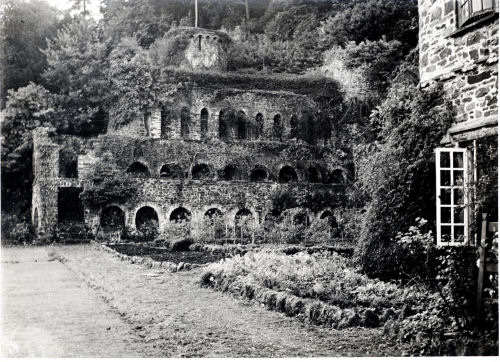
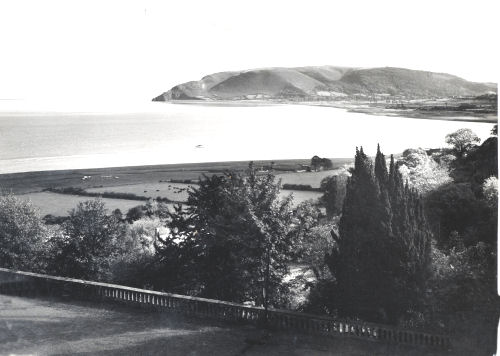
| WWW.MINEHEADONLINE.CO.UK | ||||
|---|---|---|---|---|
ASHLEY COMBE Once the home of Ada Byron, the Countess of Lovelace, daughter of Lord Byron -The first Computer Programmer |
||||
 |
 |
|||
The Terraces |
View from Ashley Combe |
Back of the house |
||
Mathematician and The First Computer Programmer
1815 - 1852 Augusta Ada King, Countess of Lovelace, born Augusta Ada Byron and now commonly known as Ada Lovelace, was an English mathematician and writer chiefly known for her work with Charles Babbage on the early mechanical general-purpose computer, the Analytical engine. Her notes on the engine include what is recognized as the first algorithm intended to be processed by a machine. Because of this, she is often considered the world's first computer programmer.
|
||||
Ashley Combe House was built in 1799 for a cost of £1300 and improved in 1835 when its owner, Lord William King (later created the First Earl of Lovelace), married Ada Byron (daughter of Lord Byron, the poet) who brought a considerable fortune with her. This enabled him to set about improving this romantic country home to please her, and probably using some of the money she brought into the marriage. The house was tucked into the woods overlooking the Bristol Channel and surrounded by most exotic terraced gardens in the Italian style. Tunnels led tradesmen up from the road to the trade entrance of the house so that those within wouldn’t have to see their carts. A woodland walk and steps led down to the beach where a bath-house was built into the cliff to enable Ada to bathe in privacy. The house, in the style of those to be found around the Italian Lakes, had an impressive clock tower, which was built in 1837. The gardens themselves consisted of walks, one above the other and backed by a row of alcoves, joined by spiral stairs. Beyond these were a series of gardens, walled at the back and sides and facing out of the woods down to the river below. These contained hot-houses. Decorative towers, turrets and archways were littered amongst the wooded walks. Local stone and rocks from the the beach were utilized, and lime was supplied from a kiln on the beach nearby. Trees such as Canadian pines, sycamore, copper beech, pinactus were planted. In the region of 100,.000 trees were transported from Lord Kings estate in Scotland. In June 1835 a cedar of Lebanon was planted near the house and a deodar planted, one month later. There were 43 apple trees, cypresses, larches, bays, stone pines, Bermuda cedars, arbutus, Luccombe oak and cork trees planted above the terraces behind the house. A pond was built below the stables to water the meadow and another to supply water for the house and top meadow. Ada had been advised to take baths for her health and there were no bathrooms installed in the house, probably due to problems with the water supply. So Ada's husband had a bath house built for her into the cliffs on the beach where she could bathe in private. The remains of the stairs down to the shore and also a small fireplace in the upper room are still visible. By 1939 the house had been let out to Dr Barnardos for the duration of the war. In 1950 it became a Country Club but was closed after a few years. It then fell into disrepair and its owner, the 4th Earl of Lytton, decided to pull it down. It was eventually demolished in 1974 on grounds of safety. Such a shame that we should loose such a historic building. The ruins are still there giving an air of mystery. |
||||
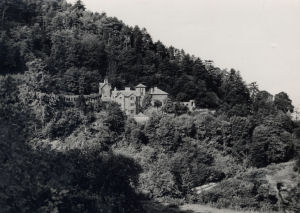 |
|---|
| The Orphanage 1940's |
Early 1950's |
Country Club 1950's | |||
|---|---|---|---|---|---|
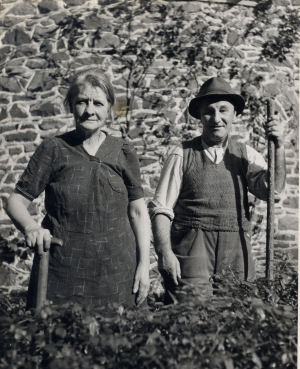 |
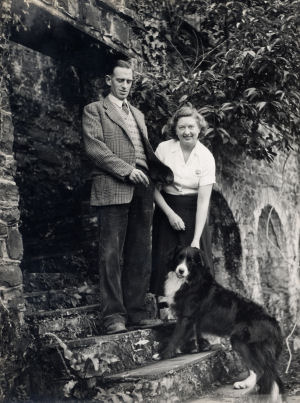 |
||||
Nath & Louie Cook. They lived at the Lodge |
Fred and Hope Messenger with their dog Pip.
|
Liz Cook & Sandy. She lived at Culbone and was well known for making cups of tea for people making the long walk to Culbone Church. She is buried in the churchyard and has a teapot on her grave. I dont know for sure if she is the daughter of Nath and Louie but Elizabeth Ann Cook was born in 1909 . Nath had a sister, Elizabeth Ann born in 1862 |
|||
Although the house has been demolished, the gardens count as a ruin in their own right, still private property and used as a pheasant run for the local shoot. The archways and spiral staircase are still to be seen as well as intriguing little dark passageways which lead away in the hills. Most of the tunnels have now been demolished, for safety, or bricked up but I remember, as a child, how eerie it was to walk along a curving tunnel where, in the middle, no daylight could be seen except through a little square hole in the roof. UPDATE: There was a project to restore the gardens in Ashley Combe but the property is now private land used for the rearing pheasants. "The significance of the gardens lie in their historical connections. First set out in 1799, they took on a particular importance when Ada Lovelace came to live here in 1835. It was her extraordinary relationship with the famous 19th century mathematician and inventor, Charles Babbage, that sets this location apart. Whilst Babbage is now widely credited with having invented the world’s first computer, his ‘Analytical Machine’ and his ‘Difference Engine’, Ada Lovelace is credited with having been a forerunner of the software programmer. It was she who, walking in these gardens with Charles Babbage, discussed with and suggested to Babbage the use to which his machine might be put. So much so in fact that the US Department of Defence named, in 1979, an early, secret software programme ‘ADA’ in her honour. ‘ADA’ continues to be used as a programme to this day". Below is part of what is left of the terraces at Ashley Combe, taken in 2004, the remaining ruins are slowly being completely cleared. |
|||||
 |
 |
||
Later photos showing one of the tunnels bricked up |
|||
 |
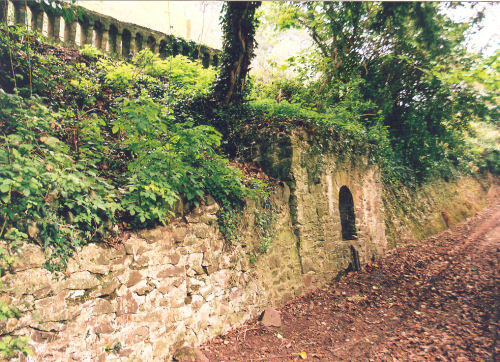 |
||
Below are remnants of the tunnels to be seen on the walk to Culbone church, taken August 2011 |
|||
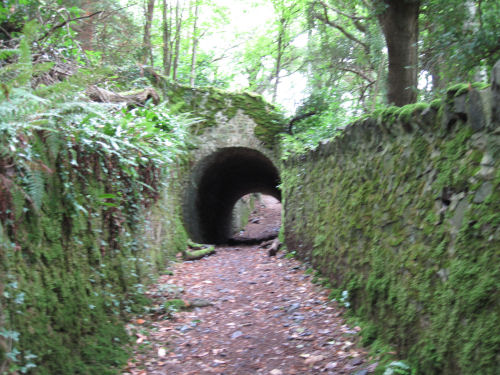 |
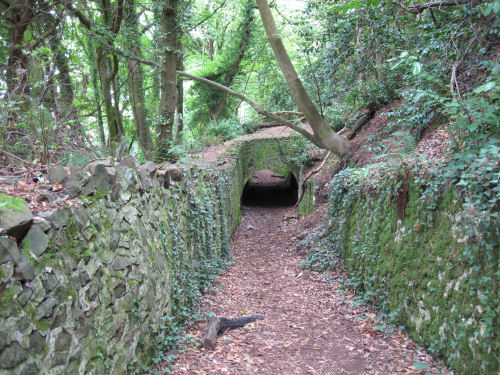 |
||
During the last war a British plane, a Halifax bomber, crashed in Yearnor woods behind Ashley Combe. At the time the area was shrouded in thick mist. Four of the crew were killed and two injured. Luckily some local men were in the area and heard the plane circling. Mr Jack Ridler, Mr Henry John Pollard and Thomas Cook rescued the surviving members. One of the crew was found badly injured near the wreck but he died later. Mr Cook and Mr Pollard pulled the pilot out from under the wing, they also recovered a body from the wreck. There was a lot of petrol vapour making it difficult to breath. This ignited causing Jack Ridler and one of the crew he was helping, to be blown down the hillside. Jack suffered 3rd degree burns but still went back to help the injured airman. He spent a month in hospital recovering. The three men received commendations for bravery. Also a B24D liberator bomber crashlanded on the beach near Porlock Weir, on 29th October 1942 -
See more at: Liberator
|
||||||||||||||||||||||||||||||||||
This picture shows the clock tower on the left with a an empty circle that once held the clock
MAIN PAGE LINKS